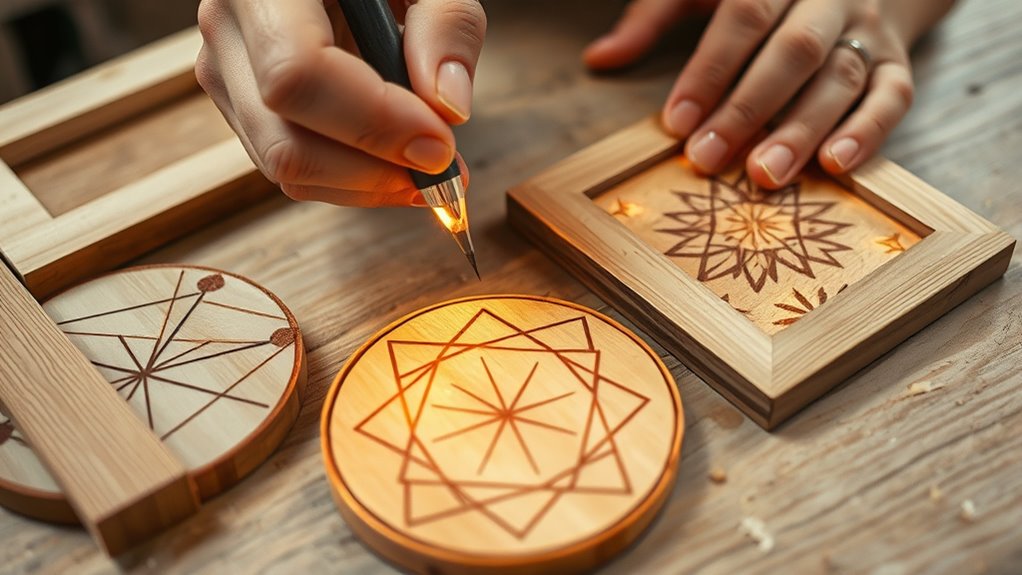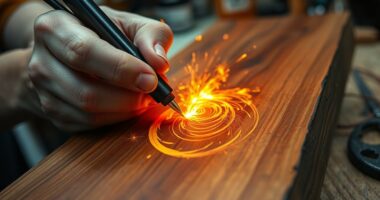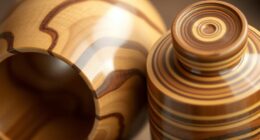Starting with pyrography projects like coasters and picture frames is perfect for beginners. You can practice creating smooth shading, fine lines, and bold outlines on simple designs. Use pencil sketches first, then carefully burn your patterns onto wood. Focus on steady hands and even pressure to achieve clean results. As you progress, you’ll learn tips to improve your work. Keep exploring more ideas, and you’ll discover how to turn these projects into beautiful, personalized decor.
Key Takeaways
- Start with simple designs like geometric patterns or floral motifs to build confidence.
- Sketch your design lightly with pencil before burning to ensure accuracy.
- Use fine tips for detailed work and broad tips for shading to enhance the project.
- Practice maintaining consistent pressure and steady hand movements for even burns.
- Finish with clear sealing or varnish to protect your coaster or picture frame.

Pyrography, also known as wood burning, offers a rewarding way to transform plain surfaces into intricate works of art. When starting out, you’ll want to familiarize yourself with basic wood burning techniques. These techniques include creating smooth shading, fine lines, and bold outlines, which all contribute to the overall look of your projects. Practice on scrap wood first to get a feel for the tool’s heat and handling. It’s vital to master these techniques early on to achieve the desired detail and precision in your designs. Understanding the arcade machine hardware can help you appreciate how detailed images are rendered in digital form, inspiring your own intricate pyrography designs.
Master basic pyrography techniques like shading and outlining for stunning wood art.
Safety tips are essential when working with a pyrography pen. Always work in a well-ventilated area to avoid inhaling fumes, especially if you’re burning on treated or painted wood. Keep your workspace clear of clutter, and never leave the heated tool unattended. Use a stand to rest your pen when not in use, and unplug it when you’re finished to prevent accidental burns. Wear protective gear such as safety goggles and a dust mask if needed. Also, make sure your hands are dry when handling the tool to avoid electric shocks, and keep a fire extinguisher nearby just in case. These safety precautions help you enjoy your hobby without risking injury or accidents.
When working on beginner projects like coasters and picture frames, start with simple designs. For coasters, you can burn geometric patterns, floral motifs, or personalized initials. Sketch your design lightly with a pencil before engraving, which helps guide your work and prevents mistakes. Use the appropriate wood burning tips to create different effects—fine tips for details, broader tips for shading or filling larger areas. Take your time; rushing can lead to mistakes or uneven burns. For picture frames, try floral borders, nature scenes, or intricate patterns that complement the photo or artwork you plan to display.
As you progress, you’ll notice that consistency is key. Keep your hand steady, and maintain even pressure on the tool. Clean your tips regularly to guarantee smooth lines and prevent buildup that can affect your work. Remember, practice makes perfect, and each project teaches you new skills. With patience and attention to safety, you’ll find that even simple coasters and picture frames can become cherished decorative pieces or thoughtful gifts. By mastering wood burning techniques and adhering to safety tips, you’ll turn ordinary wooden items into personalized, artistic creations that showcase your growing talent.
Frequently Asked Questions
What Safety Equipment Is Essential for Beginner Pyrographers?
You need to wear safety gear and protective equipment when starting pyrography. Always use a respirator or mask to avoid inhaling fumes and dust. Safety goggles protect your eyes from sparks and debris, while heat-resistant gloves keep your hands safe from burns. Additionally, work in a well-ventilated area to reduce exposure to fumes. Prioritizing proper safety gear guarantees you enjoy your pyrography projects safely and confidently.
How Do I Choose the Right Wood for Pyrography Projects?
You choose the right wood by considering its wood grain and wood type. Look for wood with a tight, even grain, like basswood or birch, which burns smoothly and shows detail well. Avoid woods with a coarse or open grain, such as oak or walnut, as they can be difficult to burn evenly. Selecting soft woods makes handling easier and results in cleaner, more precise pyrography designs.
Can Pyrography Be Used on Materials Other Than Wood?
Yes, you can use pyrography on alternative materials like leather, gourds, and certain plastics. Before you start, guarantee proper surface preparation—clean and smooth the material to avoid burn marks or uneven lines. Keep in mind that each surface reacts differently, so test your tools on a small area first. With the right technique and preparation, pyrography can add a unique touch to a variety of creative projects.
What Are Common Mistakes to Avoid in Beginner Projects?
To avoid common pitfalls and beginner errors in pyrography, you should start with simple designs to prevent frustration. Never press too hard with your tool, as it can damage the surface and produce uneven burns. Practice on scrap material first, and always keep your tool at a consistent temperature. Remember to work in a well-ventilated area, and take your time to develop steady hand control for clean, precise results.
How Do I Preserve and Seal My Pyrography Artwork?
Think of sealing your pyrography artwork as locking in a treasure map’s secrets. To preserve your masterpiece, apply a quality sealant with smooth, thin coats, letting each layer dry thoroughly. Use preservation techniques like sanding lightly before sealing to guarantee a flawless finish. This process protects your art from moisture and wear, keeping your designs vibrant and safe over time. Your artwork will shine as brightly as a gem in a treasure chest.
Conclusion
Now that you’ve explored coasters and picture frames, you’re ready to create with confidence. Embrace your creativity, experiment with designs, and learn from each project. Focus on your technique, enjoy the process, and celebrate your progress. Keep practicing, stay patient, and let your passion grow. With every stroke, you’ll improve, inspire, and craft beautiful pieces. So, pick up your tools, start your projects, and turn your ideas into stunning pyrography art.









